Repair of periorbital soft-tissue injuries and lacrimal system in NOE injuries
1. Introduction
Patients who incur orbital fractures frequently sustain equally serious injuries of the periorbital soft tissues, primarily the eyelids and lacrimal (drainage) system. Meticulous repair of the soft-tissue injuries is as important as accurate reconstruction of the bony defect.
Avulsive injuries as seen in dog bites and high energy trauma can provide unique challenges to the reconstructive surgeon.
2. Classification of eyelid lacerations
Introduction
When evaluating a patient with an eyelid laceration, there are two important determinations: first, whether the laceration is partial thickness or full thickness, and second, whether the canalicular system is involved in the injury.
Partial thickness
In this type of injury the anterior lamellar structures of the eyelid (skin and/or orbicularis muscle) are damaged and the laceration extends to the eyelid margin. The key to managing this type of laceration is a realignment of the eyelid margin so there is no discontinuity in the lashes or contour deformity of the margin.
Partial thickness lacerations of the eyelid involving the canalicular system are exceedingly rare.
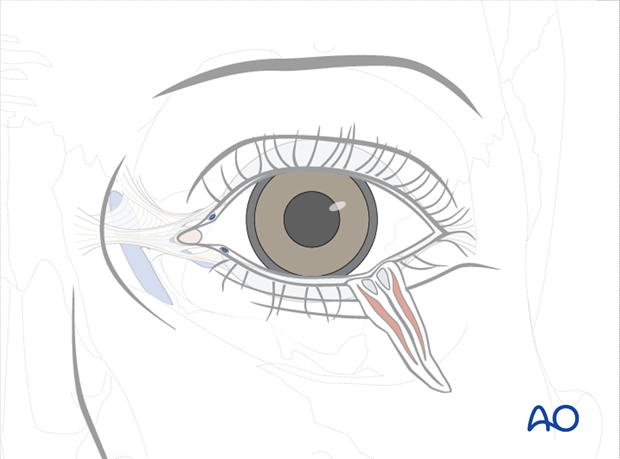
Full thickness
A full thickness laceration is defined as complete disruption of the anterior and posterior lamellar structures of the eyelid.
It is most important to determine if the canalicular system is involved. By definition, any laceration medial to the upper and/or lower punctae involves the canalicular system with rare exception. These injuries can be further subdivided into monocanalicular or bicanalicular injuries. Most monocanalicular injuries can be treated with techniques that do not require intubation of the entire lacrimal system. Bicanalicular lacerations will require utilizing a technique which places a stent through the entire system from the punctum to the nasolacrimal duct. Several systems are commercially available; the technique we show can be applied to any of these devices.
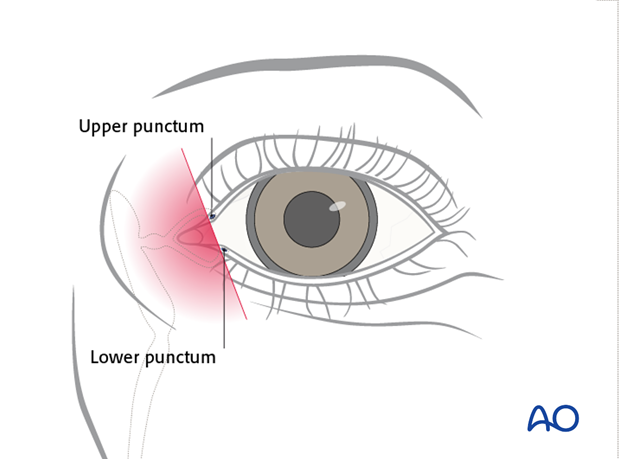
There can be more than one full thickness laceration simultaneously in a single eyelid where one involves the canalicular system and the other does not.
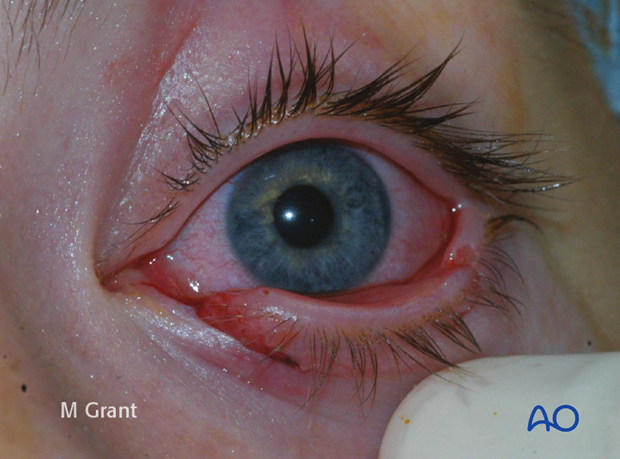
Full thickness (without canalicular involvement)
By definition, a full thickness eyelid laceration without canalicular involvement is located lateral to the punctum.
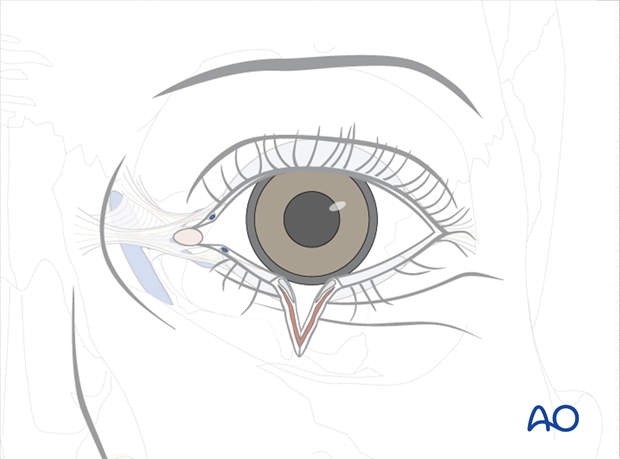
Full thickness (with canalicular involvement)
Lacerations which involve the canalicular system can damage one or both of the canaliculi. If both canaliculi are disrupted a bicanalicular intubation is required for treatment. If only one of the two canaliculi is involved, only monocanalicular intubation may be sufficient for treatment. The circumstances where monocanalicular intubation may not be sufficient include high energy injuries or injuries with a significant avulsive component such as dog bite injuries.
Monocanalicular involvement
This illustration shows monocanalicular involvement.
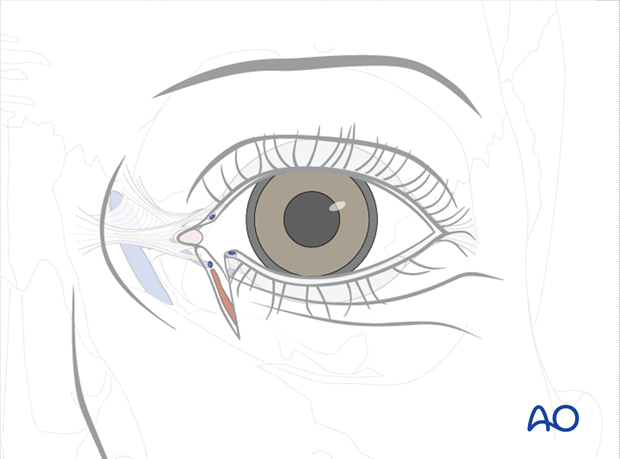
This clinical photograph illustrates inferior canalicular disruption with a significant avulsive soft-tissue injury to the lower eyelid and upper cheek. This is typical example of a monocanalicular injury that will require bicanalicular intubation.
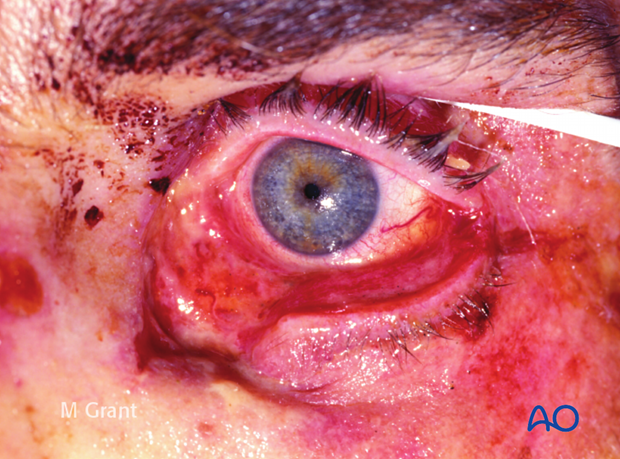
Bicanalicular involvement
This illustration shows a bicanalicular involvement.
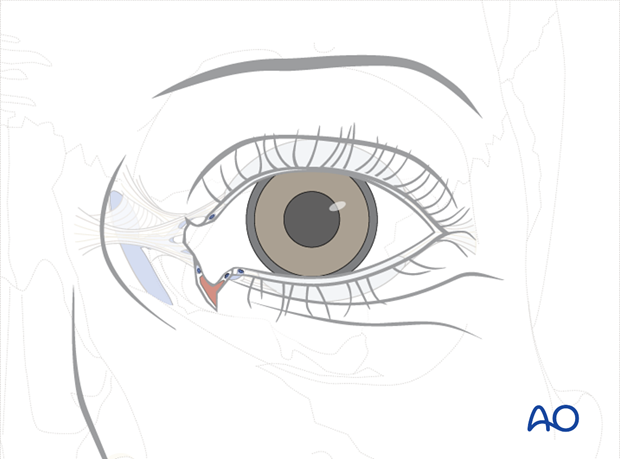
3. Repair: Partial thickness
In this type of injury the anterior lamellar structures of the eyelid (skin and/or orbicularis muscle) are damaged and the laceration extends to the eyelid margin. Accurate anatomic realignment of the margin is the most important principle in treating this injury. Prior to closure, the edges of the wound should be carefully debrided of any devitalized tissue or foreign bodies.

Next, the eyelid margin is anatomically realigned, typically with two 8.0 silk sutures oriented perpendicular to the direction of the laceration. The sutures are placed such that one is anterior to the cilia and one is posterior.
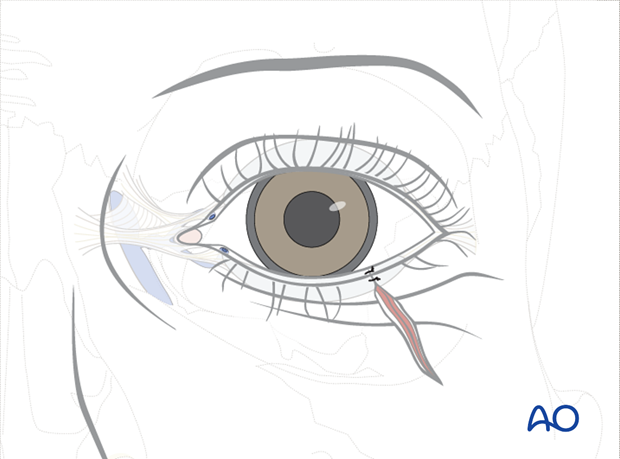
The skin is then closed with multiple interrupted monofilament sutures. Deep closure of the orbicularis muscle or orbital septum (if involved) is not essential.
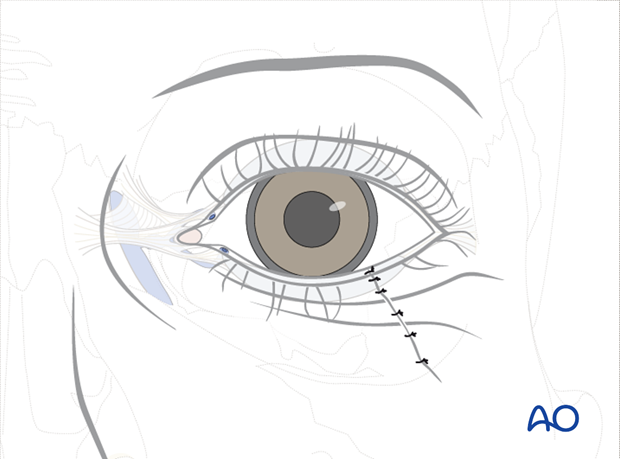
Aftercare
Typically, the wound is dressed with an ointment containing a combination of steroid and antibiotic. A non-adherent gauze pad and the eye is patched shut for 24 hours. Once the patch is removed, a regimen of combined steroid antibiotic containing eye drops is prescribed for 10 to 14 days. Generally, cutaneous sutures are removed at postoperative day 7-10, eyelid margin sutures are removed at postoperative day 10-14, depending on wound tension and soft-tissue edema.
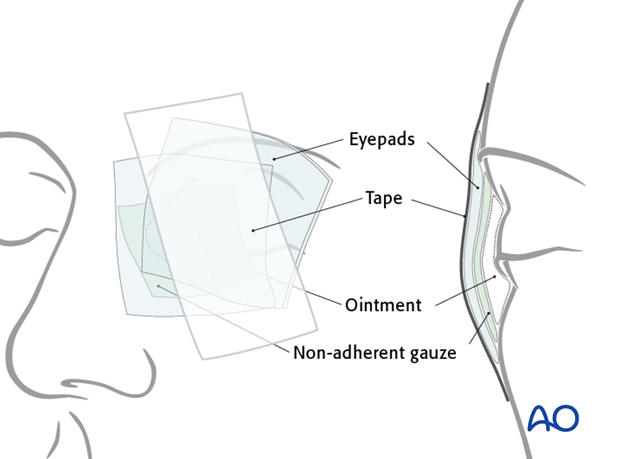
4. Repair: Full thickness (without canalicular involvement)
In contrast to a partial thickness laceration, in a full thickness laceration both the anterior and posterior lamellar structures of the eyelid are violated. This type of injury can be either sharp or blunt, and in some cases may have an avulsive component as well.

The initial step in treating this injury is reapproximation of the tarsal plate. This is accomplished by placing two to three 6.0 slow-resorbing monofilament sutures through the tarsus with the knots tied anteriorly. The number of sutures placed will depend on the location and orientation of the laceration. For example, a central oblique laceration will require three or more sutures to stabilize the tarsal plate; but lacerations at the naso or temporal aspect of the eyelid rarely require more than two.
Pitfall: do not place the sutures through the full thickness of the eyelid.
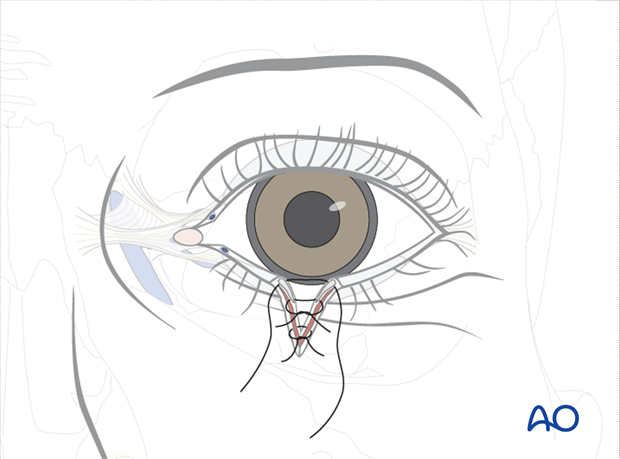
Following stabilization of the tarsal plate the surgeon should anatomically realign the eyelid margin. This is best accomplished with three 7.0 or 8.0 silk sutures oriented perpendicular to the direction of the laceration. Generally, two sutures are placed anterior to the cilia and one is placed posteriorly. Three sutures are typically required to control the rotation of the margin due to the remaining tarsal instability.
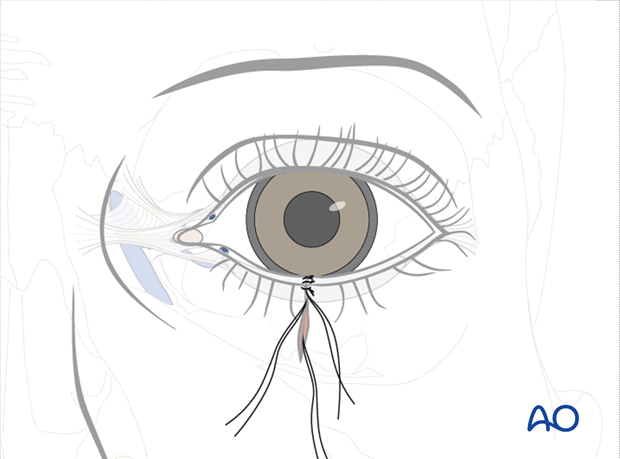
Lastly, the skin edges are debrided of any devitalized tissue. The skin is then closed with multiple interrupted monofilament sutures. Deep closure of the orbicularis muscle or orbital septum (if involved) is not essential.
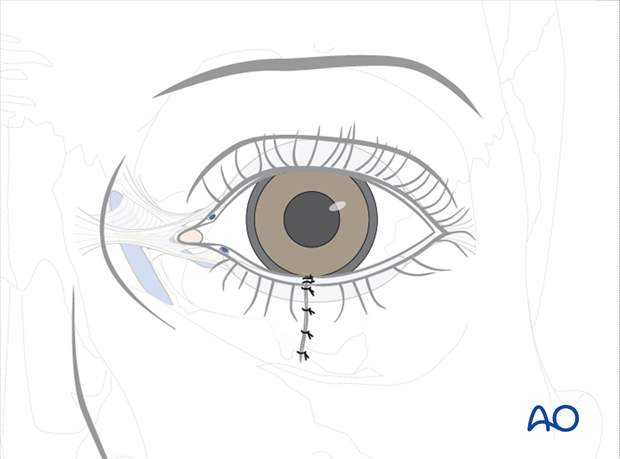
Aftercare
Typically, the wound is dressed with an ointment containing a combination of steroid and antibiotic. A non-adherent gauze pad and the eye is patched shut for 24 hours. Once the patch is removed, a regimen of combined steroid antibiotic containing eye drops is prescribed for 10 to 14 days. Generally, cutaneous sutures are removed at postoperative day 7-10, eyelid margin sutures are removed at postoperative day 10-14, depending on wound tension and soft-tissue edema.

5. Repair: Full thickness (monocanalicular intubation)
The punctum, proximal and distal segments of the involved canaliculus should be identified. In simple monocanalicular injuries, it is reasonable to proceed with monocanalicular intubation alone.
By convention, the punctum is referred to as the most proximal point of the lacrimal drain system and the nasal lacrimal duct is the most distal point.

Monocanalicular intubation is best performed with a specially designed stenting system. While the stent is in place (typically 4-6 weeks), the canaliculus is essentially blocked. During this period of time, patients may note excessive tearing.
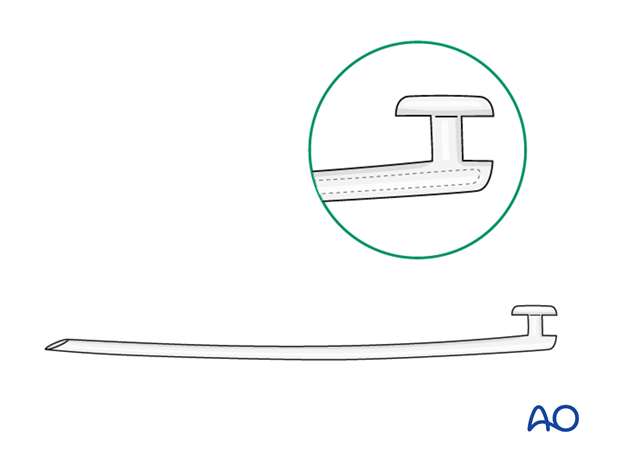
This clinical photograph shows the distal segment of the inferior canaliculus within the laceration. This can often be difficult to identify, but typically looks as shown below as white/opaque structure highlighted by the surrounding darker background.

A monocanalicular stent is threaded through the punctum and externalized through the proximal lacerated segment of the involved canaliculus.
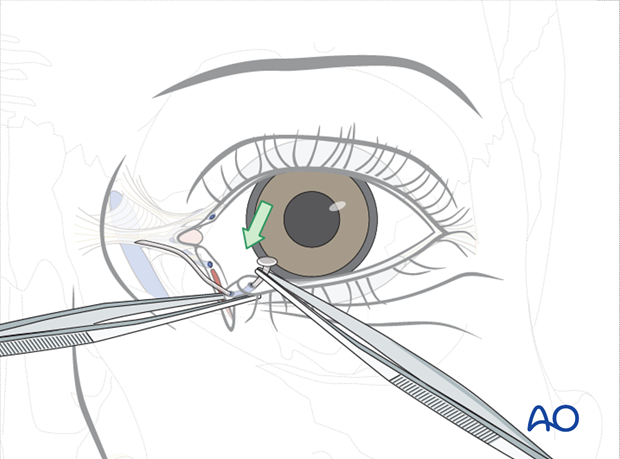
The proximal segment is then identified, and the stent is placed into the proximal segment.
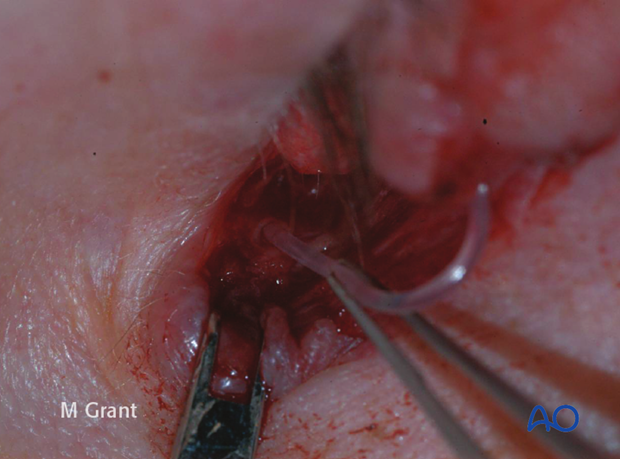
Two 6.0 slow-resorbing monofilament sutures are placed but not tied, one superior to the canaliculus and one inferior.
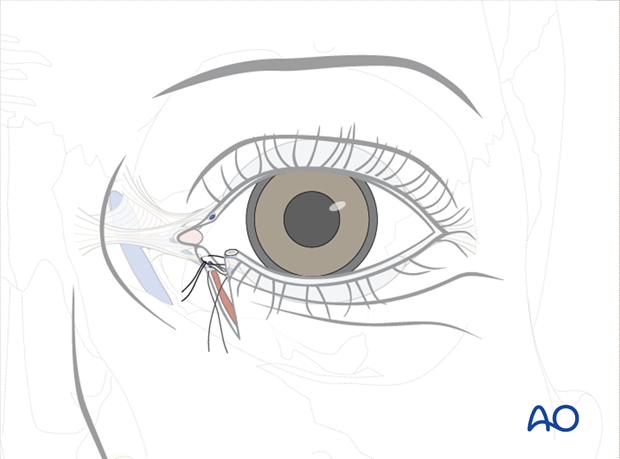
Once the sutures have been placed, the inferior suture is tied first followed by the superior suture. This will reconstruct the canaliculus and reapproximate the eyelid. One or two silk sutures may be required to anatomically realign the margin of the laceration. However, this is often not needed in contrast to when the lash-bearing region of the eyelid is involved.
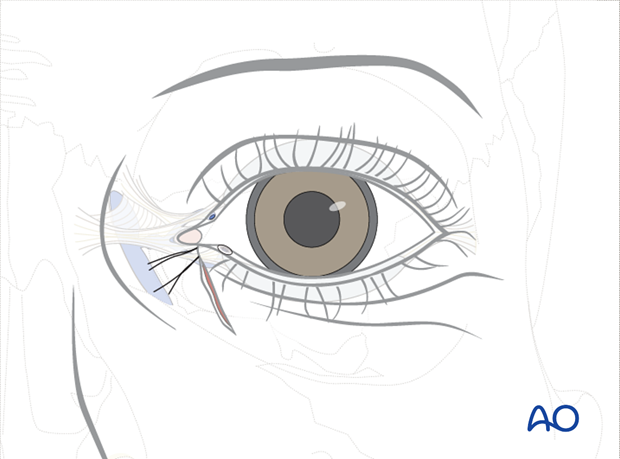
Lastly, the skin is closed with multiple interrupted sutures.
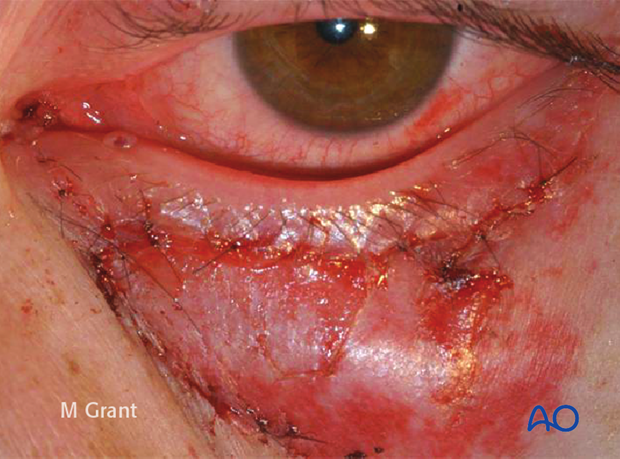
Aftercare
Typically, the wound is dressed with an ointment containing a combination of steroid and antibiotic. A non-adherent gauze pad and the eye is patched shut for 24 hours. Once the patch is removed, a regimen of combined steroid antibiotic containing eye drops is prescribed for 10 to 14 days. Generally, cutaneous sutures are removed at postoperative day 7-10, eyelid margin sutures are removed at postoperative day 10-14, depending on wound tension and soft-tissue edema.

This clinical photograph shows the patient after suture removal at 10 days. The patient will return 4-6 weeks following the repair for removal of the stent.
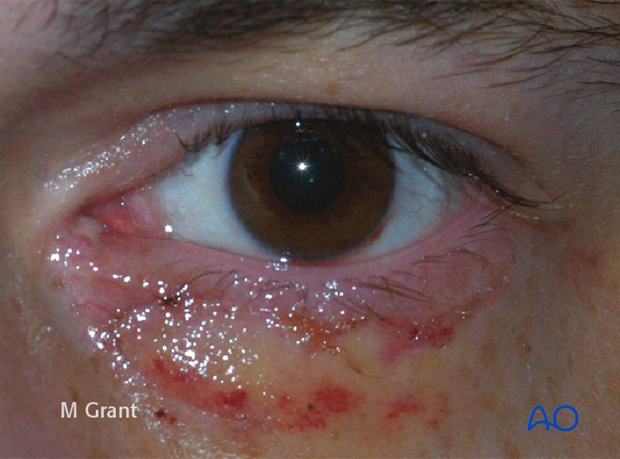
6. Repair: Full thickness (bicanalicular intubation)
In more severe eyelid trauma, including avulsive monocanalicular and all bicanalicular injuries, bicanalicular intubation is required. Below, we illustrate a technique which can be utilized with either type of injury using any of the commercial systems currently available.

In this case example the patient has sustained an inferior canalicular laceration with significant soft-tissue damage. This type of injury will require bicanalicular intubation in order to achieve optimal results.

Several systems are commercially available including the Ritleng, Guibor, and Crawford.
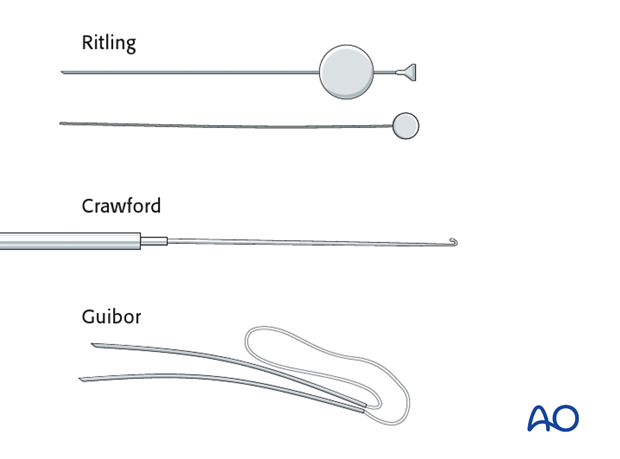
Similar to the monocanalicular intubation it is important to indentify the punctum and the proximal and distal segments of the involved canaliculi. Once this has been accomplished, the surgeon can proceed with repair. In this example, we will utilize the Ritleng system, however, the general technique is applicable for all.
First, the stent is passed through the punctum and externalized through the proximal segment within the laceration.
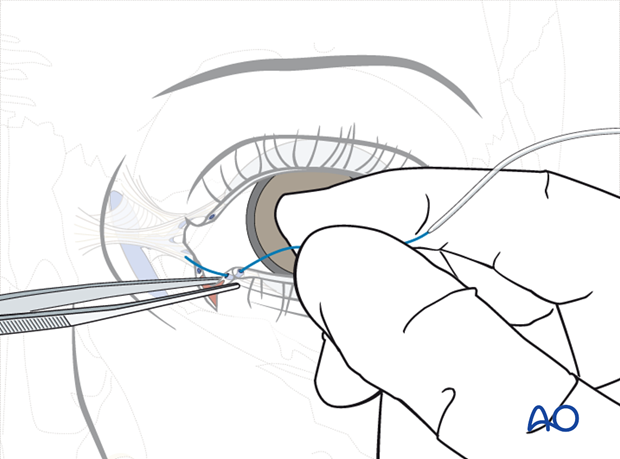
This illustration shows the anatomic shape of the lacrimal drainage system.
Note that there is a vertical segment in each canaliculus before the more horizontal component that goes to the common canaliculus, which goes into the lacrimal sac. It then turns vertically to descend into the nose as the nasolacrimal duct.
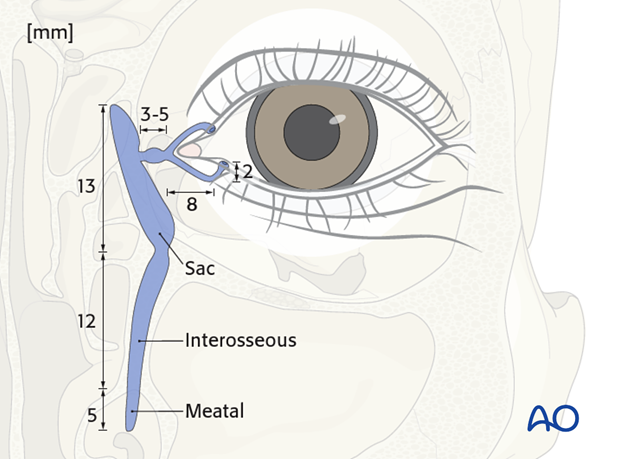
Next, the Ritleng introducer with the stylette in place is passed into the distal segment of the laceration and advanced parallel to the eyelid through the common canaliculus (parallel to the eyelid) until a hard stop is encountered. At this point, the tip of the Ritleng introduces is in the lacrimal sac. Next, the surgeon rotates the Ritleng introducer 90°superiorly so that it is now perpendicular to the plane of the eyelid and advances the introducer down the nasal lacrimal duct.
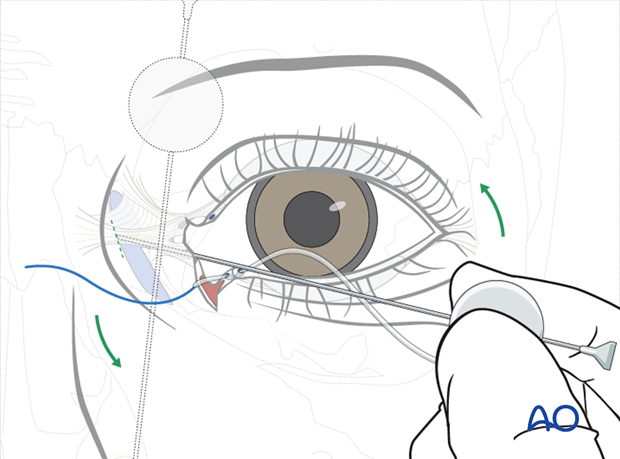
The stylette is removed and the Ritleng stent is then advanced through the Ritleng introducer into the nose. Using a Ritleng hook, the stent is retrieved from the nose.
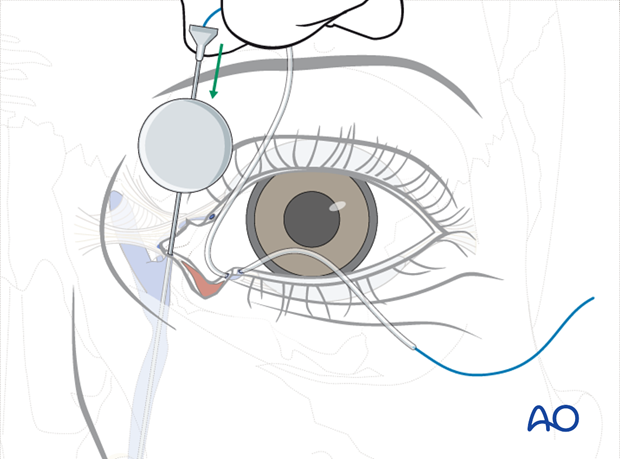
If the upper canaliculus is lacerated as well (ie, in an injury with bicanalicular involvement), then it can be intubated exactly as described for the lower canalicular intubation. If, as in this case, the upper canalicular system is intact, then the Ritleng introducer with the stylette in place is advanced through the punctum, upper canaliculus and common canaliculus until a hard stop is encountered. Then, the surgeon’s hand rotates the introducer 90°superiorly and the Ritleng introducer is advanced through the nasolacrimal duct.
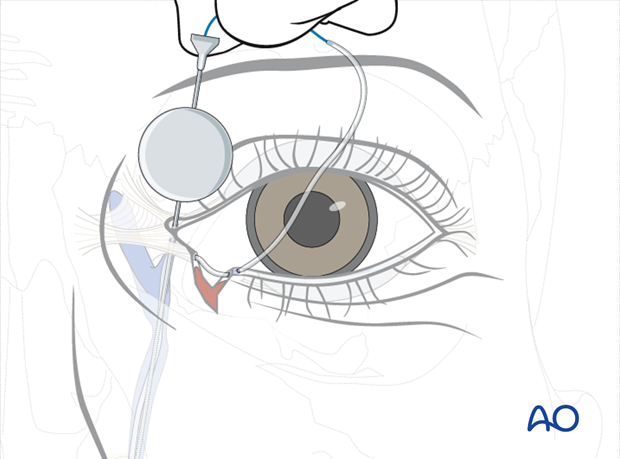
The stylette is then removed, and the other end of the Ritleng stent is fed down the Ritleng introducer into the nose. The stent is then retrieved from the nose with a blunt tipped hook.
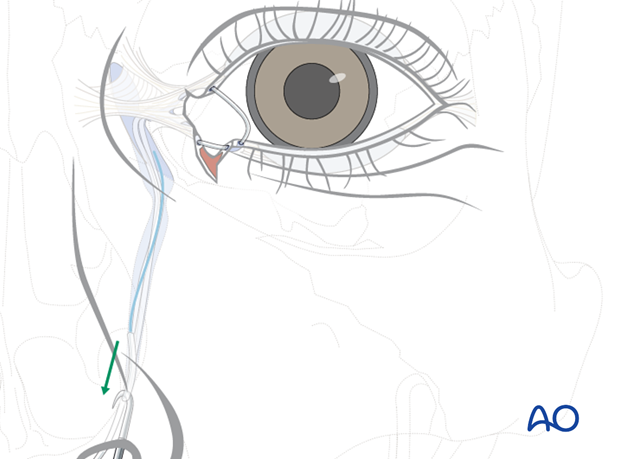
Once the stent is placed, the laceration is closed. This is done by pre-placing two 6.0 slow-resorbing monofilament sutures placed with one superior to the involved canaliculus and one inferior.
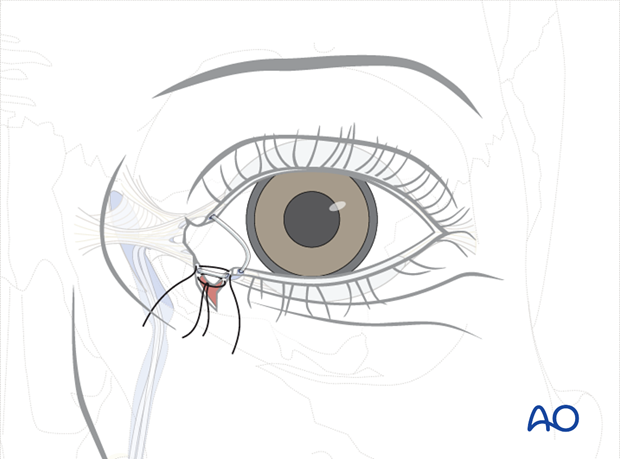
Once the sutures have been placed, the inferior suture is tied first followed by the superior suture. This will reconstruct the canaliculus and reapproximate the eyelid. One or two silk sutures may be required to anatomically realign the upper margin of the laceration. However, this is often not needed in contrast to when the lash-bearing region of the eyelid is involved.
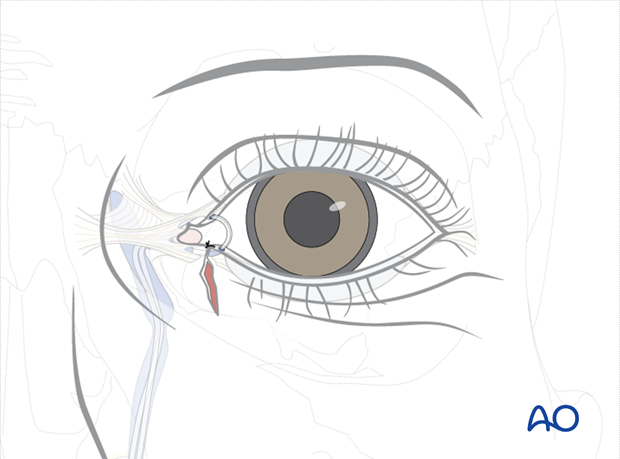
Following this, the skin is closed with multiple interrupted monofilament sutures.
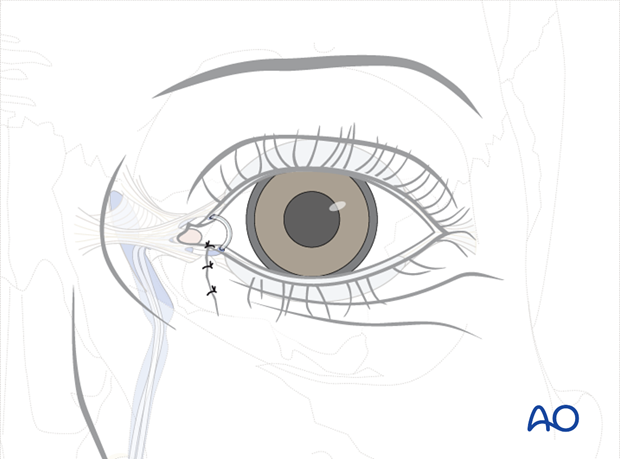
The final part of this procedure is adjusting the tension on the silicone stents. In order to do this, a 6.0 silk suture is tied around the silicone tubes at the level of the nostril.
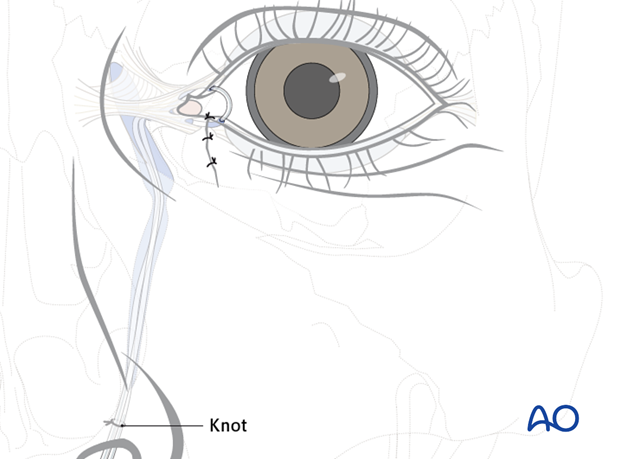
The knot is then pulled through the upper canaliculus by applying gentle traction to the silicone tube.
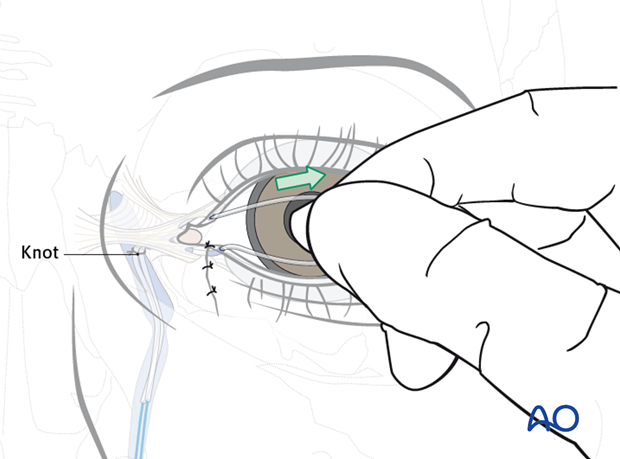
A second knot (B) is tied proximal to the first (A) corresponding to the level of the lacrimal sac. This is typically approximately 1.5 cm above the position at which the tubes emerge from the lower and upper punctum.
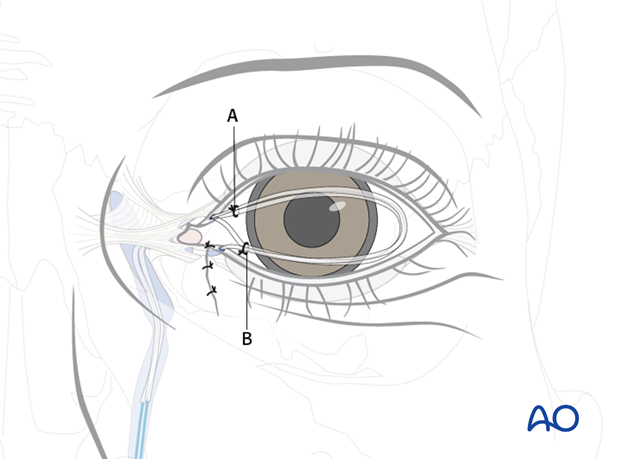
The second knot (B) is then positioned in the lacrimal sac by pulling the two ends of the stent back through the nose so that the first knot is again positioned at the level of the nostril. The stents are then cut just above the lower knot (A).
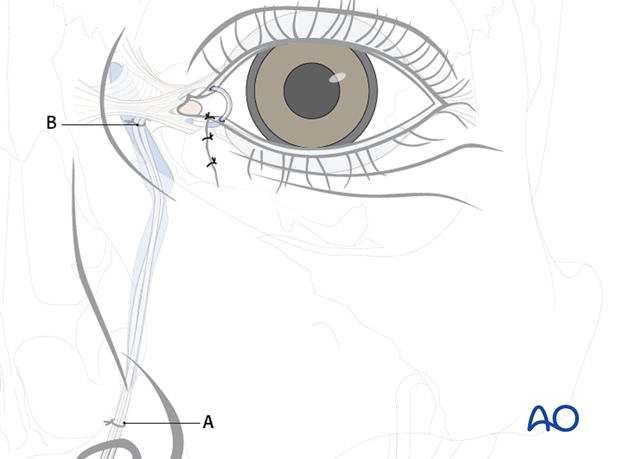
Aftercare
Typically, the wound is dressed with an ointment containing a combination of steroid and antibiotic. A non-adherent gauze pad and the eye is patched shut for 24 hours. Once the patch is removed, a regimen of combined steroid antibiotic containing eye drops is prescribed for 10 to 14 days. Generally, cutaneous sutures are removed at postoperative day 7-10, eyelid margin sutures are removed at postoperative day 10-14, depending on wound tension and soft-tissue edema.

The bicanalicular stents are left in place for approximately 3 months. At this point, the stent is removed by cutting the loop between the upper and lower punctum and pulling the stent out.
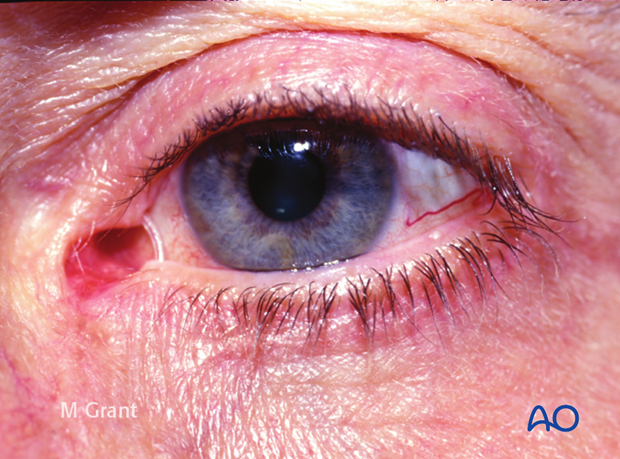
7. Involvement of the lacrimal system in NOE fractures
As in any injury that involves multiple structures, appropriate sequencing of the repair is important. If the surgeon is faced with an NOE fracture with obvious lacrimal disruption, reduction of the fracture and stabilization of the craniofacial skeleton should precede any attempt to reconstruct the lacrimal system.
Typically, even in comminuted NOE fractures, the medial canthal-bearing fragment is large enough that the eyelids and lacrimal system are not disrupted. It is only in high energy injuries or injuries in which there is a significant sharp or avulsive component, that the lacrimal system is directly injured.
These patients will have a soft-tissue defect medial to the upper or lower punctum. Patients may exhibit fractures along the path of the nasolacrimal duct. No special intervention is required other than treatment of the fracture and stenting the duct or performing a nasolacrimal duct reconstruction (dacryocystorhinostomy).
Below we will outline a method of treating lacrimal system injury in patients with a NOE fracture.
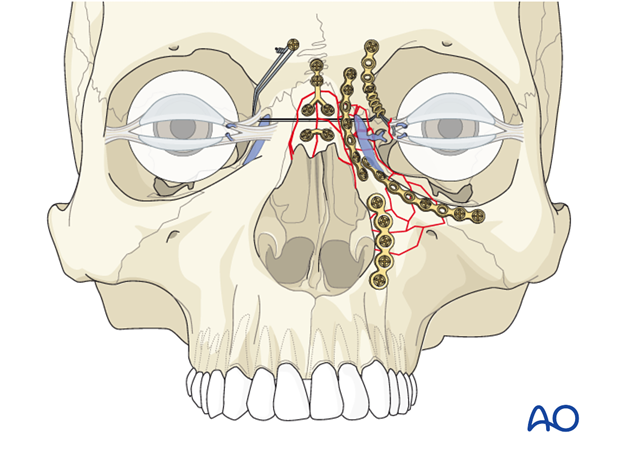
In NOE fractures which have damaged to the lacrimal system, repositioning of the medial canthal-bearing fragment is the first step in any reconstruction of the lacrimal system. This almost certainly will require stabilization with some form of transnasal wiring.
Once this has been accomplished, reconstruction of the lacrimal system can be performed.
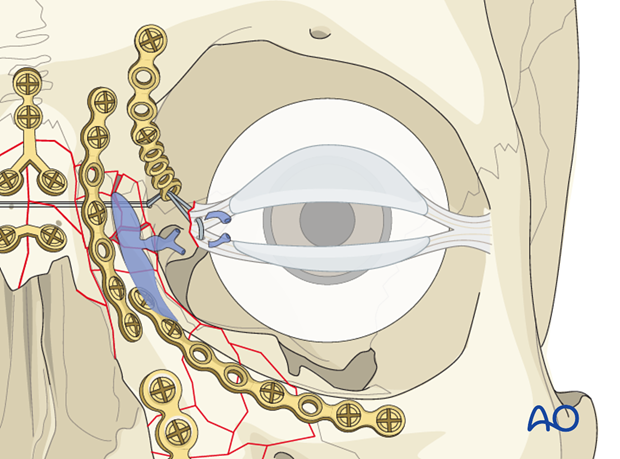
First, the proximal portion of the lacrimal system, the inferior, and superior canaliculi are identified by placing lacrimal probes within the lumen.
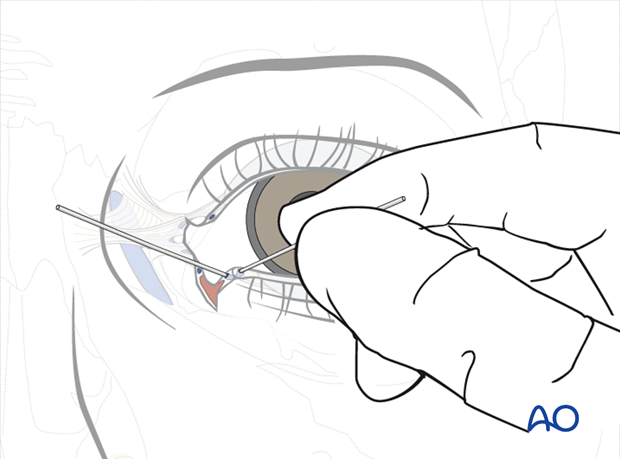
The distal segments of the affected canaliculi are identified within the laceration. 6.0 slow-absorbing monofilament sutures are then placed but not tied superior and inferior to the affected canaliculi. The probes are then removed.
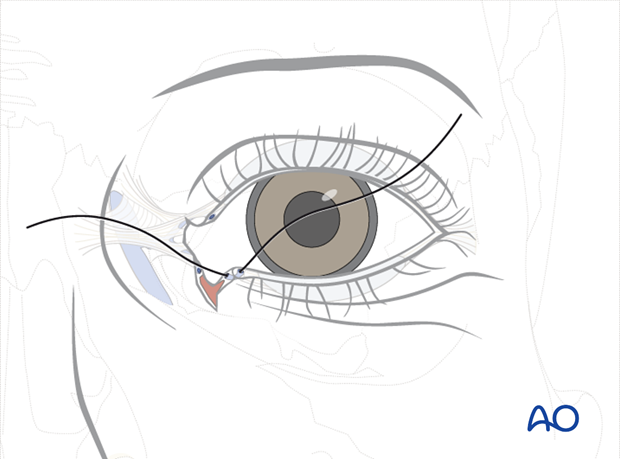
First, the stent is passed through the punctum and externalized through the proximal segment within the laceration.

Next, the Ritleng introducer with the stylette in place is passed into the distal segment of the laceration and advanced parallel to the eyelid through the common canaliculus (parallel to the eyelid) until a hard stop is encountered. At this point, the tip of the Ritleng introduces is in the lacrimal sac. Next, the surgeon rotates the Ritleng introducer 90°superiorly so that it is now perpendicular to the plane of the eyelid and advances the introducer down the nasal lacrimal duct.

The stylette is removed and the Ritleng stent is then advanced through the Ritleng introducer into the nose. Using a Ritleng hook, the stent is retrieved from the nose.

The sutures are then tightened and once the appropriate tension has been achieved, the knots are tied and the sutures trimmed. Any residual skin defect would need to be closed with interrupted sutures.
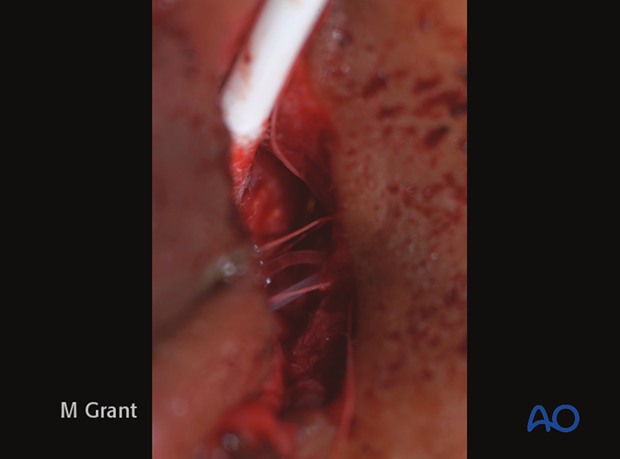
The final part of this procedure is adjusting the tension on the silicone stents. In order to do this, a 6.0 silk suture is tied around the silicone tubes at the level of the nostril.

The knot is then pulled through the upper canaliculus by applying gentle traction to the silicone tube.

A second knot (B) is tied proximal to the first (A) corresponding to the level of the lacrimal sac. This is typically approximately 1.5 cm above the position at which the tubes emerge from the lower and upper punctum.

The second knot (B) is then positioned in the lacrimal sac by pulling the two ends of the stent back through the nose so that the first knot is again positioned at the level of the nostril. The stents are then cut just above the lower knot (A).

Aftercare
Typically, the wound is dressed with an ointment containing a combination of steroid and antibiotic. A non-adherent gauze pad and the eye is patched shut for 24 hours. Once the patch is removed, a regimen of combined steroid antibiotic containing eye drops is prescribed for 10 to 14 days. Generally, cutaneous sutures are removed at postoperative day 7-10, eyelid margin sutures are removed at postoperative day 10-14, depending on wound tension and soft-tissue edema.

The bicanalicular stents are left in place for approximately 3 months. At this point, the stent is removed by cutting the loop between the upper and lower punctum and pulling the stent out.













